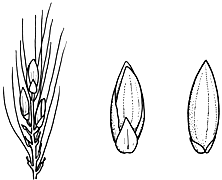Common name: Green Pigeon Grass
Setaria viridis (L.) P.Beauv. APNI* 
Description: Loosely tufted annual to 1 m high.
Culms erect or geniculate at the base, slender, rough below the panicle, 3–5-noded. Sheaths terete or subterete, usually glabrous; ligule a ciliate fringe; blade lanceolate-linear, long-tapering, 3–30 cm long, 4–10 mm wide, minutely scabrous.
Inflorescence long-exserted, mostly erect, spike-like, dense, oblong or linear-cylindrical, 1–10 cm long, branches very short, very bristly, bristles straight or flexuose. Spikelets 1.8–2.5 mm long, falling entire at maturity; bristles 1–3 below each spikelet, each to 10 mm long. Lower glume 25–35% spikelet length, triangular-ovate, obtuse; upper as long as spikelet, elliptical, obtuse. Lower lemma sterile, as long as spikelet, 5–7-nerved; palea to 50% lemma length, very thin, narrow. Upper lemma bisexual, as long as spikelet, finely rugose, convex on the back; palea flat on the back.
Flowering: Flowers in summer.
Distribution and occurrence: A weed of cultivation in temperate areas.
NSW subdivisions: *CC, *NT, *CT, *ST, *CWS, *SWS
Other Australian states: *Qld *Vic. *W.A. *S.A. *N.T.
Text by Jacobs, S.W.L., Whalley, R.D.B. & Wheeler, D.J.B.
Taxon concept: Grasses of New South Wales, Fourth Edition (2008).
APNI* Provides a link to the Australian Plant Name Index (hosted by the Australian National Botanic Gardens) for comprehensive bibliographic data
***The AVH map option provides a detailed interactive Australia wide distribution map drawn from collections held by all major Australian herbaria participating in the Australian Virtual Herbarium project.
|


